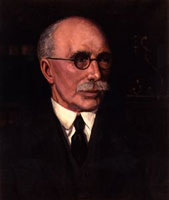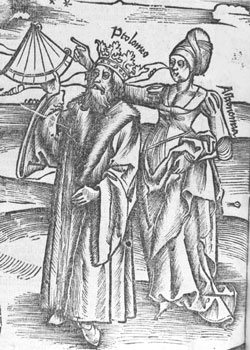
Robert Stewart Whipple (1871–1953)
 The managing director of the Cambridge Scientific Instrument Company from 1905 to 1935, Robert Whipple started to collect antique scientific instruments and rare books of science in the 1910s. In the 1940s he was involved in the foundation of the British Society for the History of Science. With the donation of his instruments to the University of Cambridge in 1944, he intended to promote the establishment of a science museum, while the books were to become the first nucleus of its reference library. In addition to the main donation in 1944, he continued to present rare books until his death in 1953. Over the next forty years the history of science as an academic discipline in Cambridge was built around his collections. The Whipple Library and the Whipple Museum are now sited in adjacent rooms; this allows the visitors easily to combine essential sources for research in the history of science.
The managing director of the Cambridge Scientific Instrument Company from 1905 to 1935, Robert Whipple started to collect antique scientific instruments and rare books of science in the 1910s. In the 1940s he was involved in the foundation of the British Society for the History of Science. With the donation of his instruments to the University of Cambridge in 1944, he intended to promote the establishment of a science museum, while the books were to become the first nucleus of its reference library. In addition to the main donation in 1944, he continued to present rare books until his death in 1953. Over the next forty years the history of science as an academic discipline in Cambridge was built around his collections. The Whipple Library and the Whipple Museum are now sited in adjacent rooms; this allows the visitors easily to combine essential sources for research in the history of science.
Scope of the collection
The most distinctive feature of Whipple's collecting was the integration of scientific instruments and of books illustrating their construction and use. The book collection amounts to ca. 1300 volumes and includes publications on scientific instruments ranging from medieval instruments for astronomical observations to early twentieth-century industrial technology. Whipple's interests led him to appreciate and collect, in addition to more canonical 'landmarks' of science, the works of less known scientific practitioners.
Three major fields are particularly well represented:
- Renaissance books of astronomy and practical mathematics, including surveying and navigation
- Seventeenth- and eighteenth-century books on the new philosophical and optical instruments
- Books on nineteenth- and early twentieth-century instruments

Renaissance
Woodcut of Ptolemy observing the stars with a quadrant, guided by Astronomy. From an edition of Gregor Reisch's Margarita philosophica (Argentine: Joannes Gruninger, 1512) STORE 55:27.
Whipple was particularly interested in the early modern production of astronomical and astrological works. Several commentaries on the canonical textbook of Sacro Bosco and works on astronomical instruments such as the astrolabe and the armillary sphere are in the collection. Of particular interest are the books by the German mathematician Peter Apianus and by the prolific, but little known, Giovanni Paolo Gallucci, whose works rich in volvelles are wonderful examples of the versatility of the early book production. Numerous German books on astronomical and surveying instruments as well as on sundials illustrate the extraordinary development of instrument production in the German Empire. English works of practical mathematics, including the production of Thomas Digges, Robert Recorde, John Blagrave and John Napier complement the editions of ancient works of mathematics by the Italian Commandino and Tartaglia. Johannes Angelus' Astrolabium (Augsburg: Erhard Ratdolt, 1488), Hyginus' Poeticon astronomicon opus (Venice: Erhard Ratdolt, 1482) and Gerardus Cremonensis' Theorica planetaru[m] feliciter incipit (Venice: Franciscus Renner [Franz Renner] de Hailbrun, 1478), originally bound with Iohannis de Sacrobusto anglici viri clarissimi Spera Mundi, are the incunables presented by Whipple.
Seventeenth and eighteenth centuries
The enormous seventeenth-century interest in the construction and use of telescopes, microscopes and other optical devices, such as mirrors and camerae obscurae is represented in the collection by the works of Scheiner, Descartes, Campani, Divini, Hevelius, Fontana, Hooke, Leeuwenhoek, Cherubin d'Orleans, Zahn and others. Whipple was also intrigued by the early Jesuits' fascination for machines, automata and other magic and spectacular devices which are described and represented in the numerous works of Athanasius Kircher and Kaspar Shott. The collection includes seventeenth-century books of mathematical and rational recreations and is rich in the publications by the English mathematicians William Leybourn and Edmund Gunter. German works on surveying and mining up to the eighteenth century are also present. The works of eighteenth-century English and Continental instrument-makers including George Adams and Nicolas Bion offer a wonderful opportunity to investigate the iconography of scientific instruments. In addition to these, the Library has a fairly complete collection of the works of Benjamin Martin. Of the greatest interest is the collection of Boyle's works, which Whipple assembled with particular care. It comprises 140 items, including some extremely rare editions.
More about the Robert Boyle Collection
Late nineteenth and early twentieth centuries
This section is smaller than the others, but it is equally interesting. In addition to books of optics, and in particular textbooks of microscopy, Whipple collected popular treatises on instruments, works documenting the industrial production of instruments, as well as catalogues of nineteenth- and early twentieth-century scientific instrument companies. A substantial collection of trade ephemera belonging to the Cambridge Scientific Instrument Company is now in the Library. Among the few manuscripts in the collection, an album of autographs of nineteenth-century scientists, including Darwin and De Morgan, is of particular interest.
Provenance
Some books in the collection have extremely interesting provenance. Among these, Ben Jonson's and Montesquieu's copies of Gilbert's De Magnete; Borelli's copy of Gilbert's De mundo nostro sublunari; Newton's copies of Boyle's Tracts consisting of observations about the saltness of the sea and of Wallis' Opera mathematica, Hooke's copy of Fermat's Varia opera mathematica, Boyle's copy of Huygens's Horologium oscillatorium, Flamsteed's copy of Wing's Astronomia Britannica. Among the books which formerly belonged to more recent collectors, Whipple acquired Augustus De Morgan's copy of Guericke's Experimenta nova and several books from Pierre Duhem's library. These names, in addition to those of less-known owners, who appear in more than one book, confirm the potential of the Whipple collection as a source for documenting the history of the collecting and dissemination of science books.
A growing collection
Since the 1950s the book collection has grown substantially. In addition to the Whipple Collection, the Library now holds more than 3000 rare volumes. They include those books on instruments and science which have been acquired thanks to Whipple's special bequest, the collection of medical books bought with the Wellcome fund, the Phrenology Collection (ca. 300 volumes), the Sleeman and the Steward Collection of books of chemistry and physics, the collection of books presented by George Parker Bidder (books of biological sciences from the nineteenth-century onwards), and some of the books originally presented to the Cavendish Laboratory by James Clerk Maxwell. Three incunables have been added: a collection entitled Scriptores astronomici veteres, including Firmicus Maternus' De nativitatibus (Venice: Aldus Manutius, 1499); a volume containing Sacro Bosco's Sphaericum opusculum [Sphaera mundi], Regiomontanus' Contra Cremonensia in planetarium theoricas delyramenta disputationes, Peurbach's In eorundem motus planetarum accuratissime theoricae (Venice: Erhard Ratdolt, 1482); and Solinus' Polyhistor, sive De mirabilibus mundi, (Venice: [Joannes Rubeus Vercellensis], 1498).
Making the collection accessible
The Whipple Collection has been fully catalogued and researched in depth, using the information which Whipple recorded in a notebook and a card catalogue. Detailed records have been added to the online catalogue. The research has led to a wider project on patterns of collecting science books, at the intersection of the history of science and the history of the book. An exhibition on Whipple's pattern of collecting science books and on the production, circulation and use of books on scientific instruments since the introduction of print was displayed in the Whipple Museum from November 2000 to June 2001.
[Instruments in Print: Books from the Whipple Collection. An Exhibition Curated by Silvia De Renzi. November 2000–June 2001. With accompanying catalogue (Cambridge: Whipple Museum of the History of Science, 2000. – x,107p: ill; 24cm. – Includes bibliography. – £8.00 + p&p.). To order a copy, please contact the Library.]
So far, the printed catalogues documenting some of Whipple's books are D. Bertoloni Meli & J. A. Bennett, Sphaera Mundi. Astronomy Books in the Whipple Museum 1478-1600, Cambridge, 1994; S. A. Johnston, F. H. Willmoth and J. A. Bennett, The Grounde of Artes Mathematical Books of 16th-century England, Cambridge 1985; S. Butler, R. H. Nuttal, O. Brown, The Social History of the Microscope, Cambridge, [1986].
This page was written by Silvia De Renzi.
